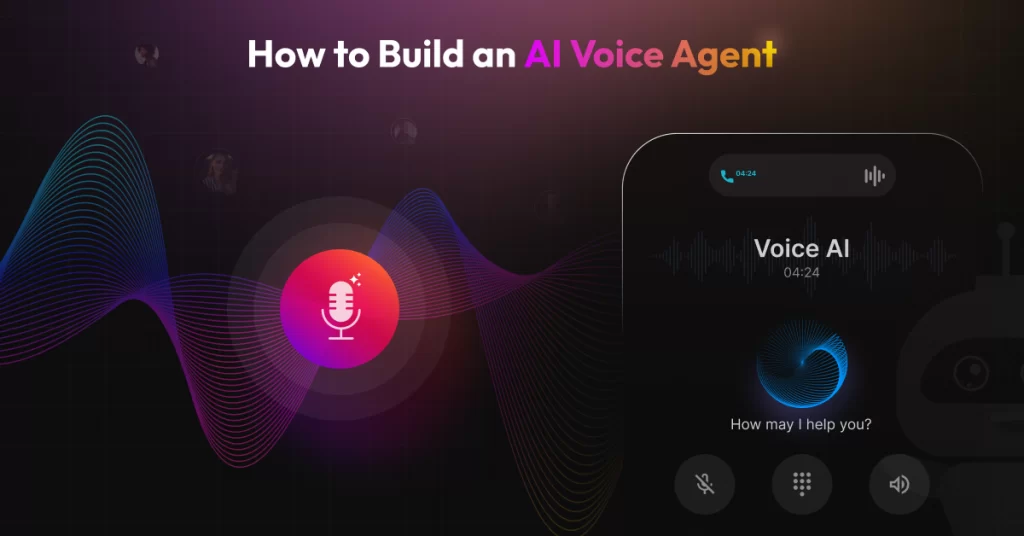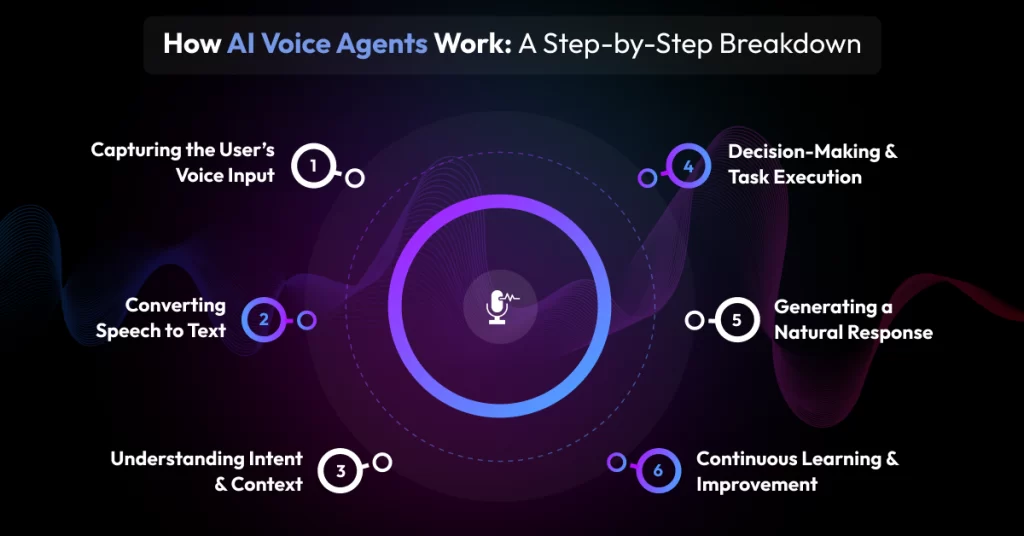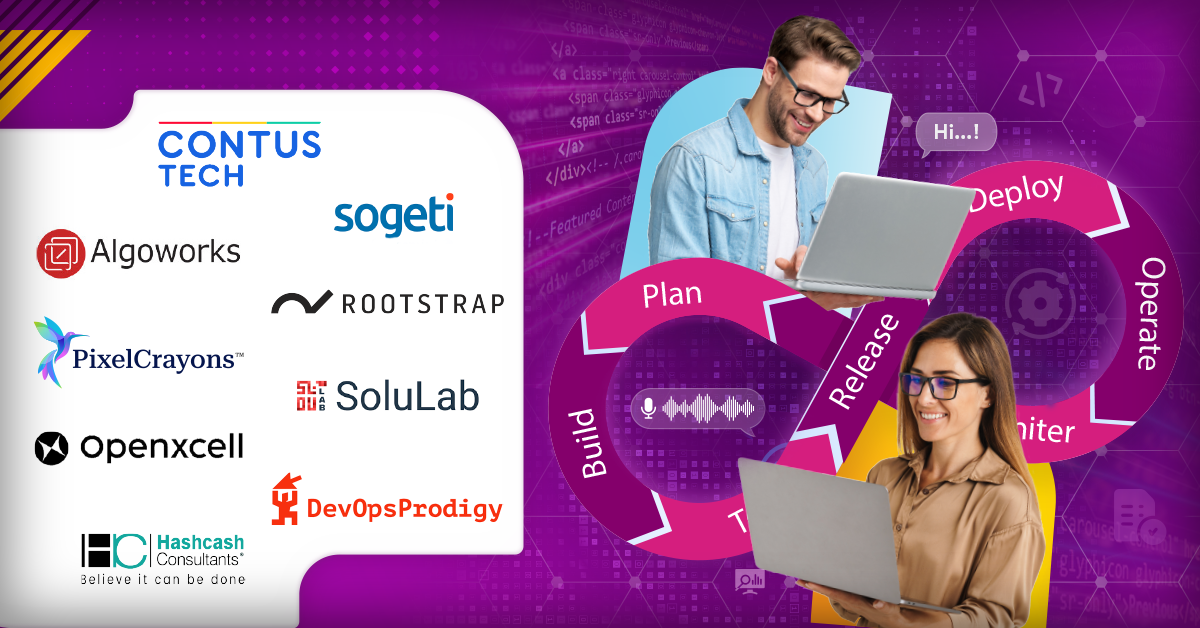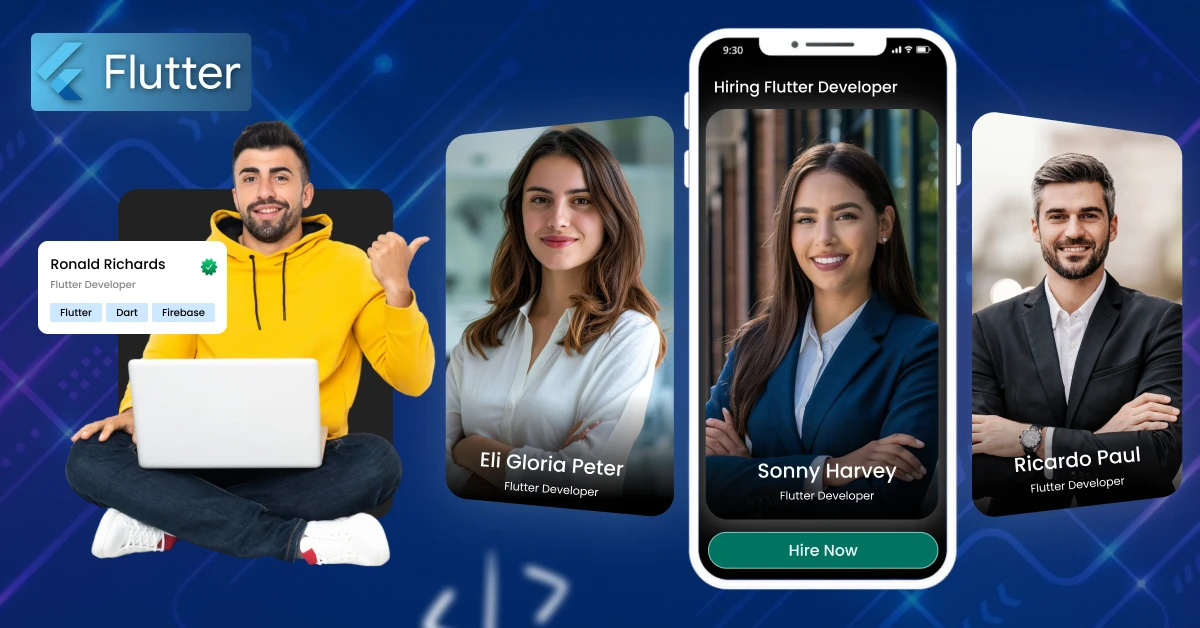How to Build AI Voice Agent? Process, Cost & Features

It didn’t take that long for people to start using the voice feature of ChatGPT. Perfect for when you are driving, cooking, or drafting an email while having a meal.
Well, business owners like you are starting to explore how to build an AI voice agent to improve customer service and automate tasks. These nifty AI voice assistants handle multiple queries at once, never sleep, and continuously improve through self-learning.
Let’s look at some numbers. According to Gartner, in 2026, AI voice agents will reduce the contact center labor costs by $80 billion.
Why? Because AI voice agents can detect the sentiment behind the speaker’s tone, slow down their pace, use empathetic language, and proactively offer a solution. That is personalization and human-like intelligence packed in one smart tool to transform your business.
If you searched for how to develop AI voice agent for your business, here is a practical step-by-step guide to build your first AI voice agent from scratch. By the end of this blog, you will have a clear idea of where to start and how to create AI voice agent.
Key Takeaways
- A Grand View Research stat projects that the market size of voice user interface will reach $92.41 billion by 2030, which is a 21.3% CAGR increase from $19.73 billion in 2022.
- AI voice agents can understand multiple languages, accents, and dialects. This allows businesses to serve diverse global customers without human intervention.
- They trigger backend workflows automatically (refund approvals, ticket escalation, CRM updates) based on detected intent. This eliminates human bottlenecks and speeds up resolution rates.
- Businesses can choose to build AI voice agents from scratch or go for pre-built platforms depending on their budget, business goals, and the level of control required.
- Building a focused voice agent MVP with the necessary use cases reduces risk, speeds up launch time, and helps validate the performance before going into scaling other features.
- A successful voice agent is defined by its high-performance ASR, NLU, NLP, and TTS engines working to deliver human-like responses.
Table of Contents
What is AI Voice Agent?
An AI voice agent is a type of intelligent software engine that utilizes speech recognition and natural language processing to participate in real-time two-way conversations over the phone or other voice connections.
These agents have the ability to understand, interpret, and act upon human speech and do tasks like responding to questions, solving problems, and making appointments. In contrast to traditional automated systems, AI voice agents are capable of complex and unscripted conversations in a natural, human-like conversation flow.
Benefits of Voice AI Agents for Your Business
The voice AI agents are changing the business-to-customer relationship by adding smarter, faster, and more personalized services. They reduce waiting times, offer 24/7 access, and uncover valuable insights from every interaction.
And while many businesses wonder which voice assistant is best for their needs, the real advantage lies in how effectively these agents enhance customer experience and operational efficiency. Here are a few key benefits of AI voice agents.

✅ A Smoother Experience for Users
The AI voice agents offer 24/7 availability, and customers do not have to wait. They provide low wait times and human-like service, which makes the experience uninterrupted with high quality in all the calls made. This reduces the mistakes and customer frustration.
For example, an e-commerce brand can utilize a voice AI app to help the shopper with checkout processes at any moment. It can also respond immediately and modify the answer based on his or her tone and preferences while keeping the interaction natural.
The result? Satisfied clients and easier customer relations that lead to loyalty.
✅ Making Services More Accessible
Voice AI agents eliminate barriers by providing multilingual assistance, which makes services available to international target audiences. Their natural multi-lingual support can enable businesses to cater to more users without recruiting new personnel.
This, along with 24/7 services and fewer wait times, means that everybody will receive service when they require it.
For example, a healthcare provider may rely on a multilingual voice agent to make appointments or give instructions in multiple languages, which enhances user satisfaction and inclusiveness and minimizes the workload of human agents.
✅ Insights you can Actually Use
AI voice agents record insights on all interactions based on data, and this data can help companies get insights on customers and enhance business strategies. These agents discover pain points in real-time and opportunities by analyzing tone, sentiment, and conversation trends.
For example, a telecom company may monitor recurrent requests concerning problems in billing, and the business can take action to refine operations, minimize complaints, and maximize customer service.
This converts raw voice communication into actionable information and assists groups in making sound decisions, but also ensures consistent quality and personalized interactions.
✅ Smarter Use of your Time and Money
AI voice agents also assist businesses in maximizing resources and operations by responding to routine queries and business activities automatically. The reduced man-hours of make teams concentrate on high-value activities such as strategy, innovation, and customer-relationship building.
For example, an insurance company can create an AI voice agent to handle policy renewals, policy claim status, and frequently asked questions, to allow human agents to deal with complicated cases.
How AI Voice Agents Work: A Step-by-Step Breakdown
AI voice agents work with a wake-word detector, record and filter the audio of the user, turn speech into text, and process intent based on NLP and entity extraction. Developers then select an approach to building (custom models or platforms) and then develop conversation flows with contextual logic.
A focused MVP is designed in order to validate key use cases prior to integrating the agent with CRM, ERP, etc. The solution is then tested on the devices, accents, and workflows, and rolled into production and optimized through logs, feedback, and updates to the model.
Let us take a deeper look at what happens when an AI voice agent hears a wake word.

1️⃣ Capturing the User’s Voice Input
The very first step a conversational AI does is start listening to the user when the wake word is said. A wake word is how you can get the AI voice assistant to work. A keyword like “Hey Siri,” “Okay Google,” or “Hey Jarvis,” if you will. Wake word detection is how the AI voice agent knows you are giving it a command.
AI voice assistants then capture the sound waves produced when a user speaks. The microphone in the device captures these waves, which are then converted to audio signals.
The goal of the Voice AI at this point is to record clear speech. This captured audio goes through signal processing, where the audio is cleaned and prepared for the next step.
2️⃣ Converting Speech to Text
How will the AI voice agent know to filter your voice in case there is background noise? Well, these conversational AIs are built with a Voice Activity Detection (VAD) filter that isolates real speech from noise.
This filtered audio is sent to the STT (Speech to Text) engine for transcription. The STT processing is quick and can understand the intent and tone of voice to respond accurately.
3️⃣ Understanding Intent and Context
Once the speech is converted to text, Natural Language Processing is done to interpret the meaning behind the user’s request. Intent recognition is used to identify the user’s goal, and then entity extraction pulls important information from the query and from the database.
So how to build an AI voice agent that can analyze speech patterns, accents, and even sentiment? You have to make sure to use an Automatic Speech Recognition (ASR) engine. This helps maintain accuracy even in the midst of background noise and stay aligned with intent and context.
4️⃣ Choose Your Development Approach
Would you rather create AI voice assistant Jarvis with Python for your business and feel cool, or would you rather build a voice assistant using JavaScript for deeper control? What development approach you choose paves the foundation for how your AI voice agent handles user input.
You can build AI voice agent from scratch using OpenAI Whisper, GPT-4 or Google Speech-to-Text, or go for platforms like Google Dialogflow, Amazon Transcribe NLP, or Azure TTS.
For businesses that need advanced customization can explore building intelligent AI voice agents with Pipecat and Amazon Bedrock. It can also be combined with the Core Tech Stack, like ASR, NLU, NLP, and TTS.
Honestly, the right combination should depend on your business goals rather than what your competitors are doing.
5️⃣ Design Effective Conversation Flows
You know how AI voice agents handle real conversations effectively? It has a conversation design flow. It includes mapping the user journey by having clear user paths and providing fallbacks where the voice agent AI cannot process some queries. After all, what is AI voice agent without a well-structured conversational foundation?
This is where you train your voice agent with contextual data. Make flowcharts containing interruptions, pauses, barge-in, and backtracking. Ensure that your AI voice agent has a coherent tone, personality, and brand identity throughout all the conversations.
Implement Natural Language Understanding (NLU) to manage conversational complexity, define logic, and sequence. This approach strengthens voice UX when planning how to create AI voice agent systems for business tasks.
6️⃣ Build a Focused MVP
Before you scale your AI voice agent, build a focused MVP to develop voice agent features that can solve one or two niche, complex problems. You do not need to plan each interaction. Simply focus on high-value flows such as authentication, support queries, or scheduling.
The goal is to create realistic AI voice agents that sound natural in real scenarios and follow the designed conversational flow. An MVP that has been thoroughly tested assists you in unraveling problems early on, before you make any decision to expand on the features.
7️⃣ Integrate with Your Existing Systems
In order to make your Voice AI truly useful, you need to build an AI voice model that can connect with your existing systems. Build and deploy the voice layer to enable your agent to communicate with CRM, ERP, databases, mobile applications, phone systems, or websites.
You can make use of APIs and integration platforms to connect your AI voice agent with workflow tools. This will assist the voice agent to retrieve appropriate information, workflow, and integrate perfectly in your business processes and smart speakers.
8️⃣ Test & Validate for Accuracy
When you are building AI voice agents for production, make sure they perform reliably across different environments, accents, and user inputs. Start by testing voice input and voice output for different devices like mobile apps, web platforms, phone systems, and smart speakers like Alexa or Google Assistant.
Check for interruptions, delays, and unusual commands. When you test your AI voice agent, validate with APIs, integrations, databases, and workflow tools. This will assist you in understanding how it provides the right answers, real-life interactions, and user satisfaction.
Review logs and analytics and collect feedback, and refine your voice agent AI before launching.
9️⃣ Deploy and Continuously Optimize
The real work begins once your AI voice agent is live. The aim of the last step is to learn how to create AI voice agent that remains accurate despite the change in the behavior of the user.
Keep track of actual dialogues, log mistakes to understand in which areas your voice AI agent is still lagging. Update the AI model, fine-tune the intents, and adjust workflows based on new queries.
Continuous optimization is what helps your voice agent to adapt to new slang, accents, and expectations, keeping the performance accurate for the long run.
Should You Build a Custom AI Voice Agent?
Deciding whether to build a custom AI voice agent is often a strategic decision. Whether you want to build an AI voice agent for sales, production, or customer support, your choice will impact development time, costs, and control over features.
Here is a short guide to help you decide.
🚨🚨 Option 1: Building from Scratch
When you want to have control over every stage of development, choose to build AI voice agent from scratch. It is a more desirable approach when you have a robust AI software development team, which can customize dialogue flows, responses, and deal with errors.
Be mindful that you will have to undergo several testing stages to check response times, spot delays, and review logs for failures. You also need to perform the A/B testing of various features of your AI voice agent in order to examine the performance data and feedback.
In short, building from scratch gives you deep control over functions, locations, and customization options. However, it is time-consuming and expensive.
🚨🚨 Option 2: Using Pre-Built APIs and Platforms
What if speed and simplicity matter to you most, and if you want a more practical path? In that case, how to build AI voice agent that is reliable?
You may choose ready-made tools that provide dialogue flow, response, and natural interaction. This would allow you to roll out your MVP sooner and test versions, inspect logs, and receive feedback without needing to manage the entire backend operations.
Platforms like Google Dialogflow, Amazon Lex, and Azure TTS include built-in error handling and voice tuning for different commands and accents. This makes it less complex and allows you to personalize responses.
Ready-made APIs and platforms would be preferable when you are interested in strong performance without all the heavy lifting.
Important Features of an AI Voice Agent
From natural language understanding to lightning-fast response times, these features determine how well your AI agent can handle high volumes, complex queries, and maintain consistent customer satisfaction.
Understanding the important features of an AI voice agent will help you identify what capabilities matter most when planning how to build AI voice agent systems that are human-like, efficient, and scalable.
🎯 Natural Language Understanding
To develop AI voice agent that is human-like, it must have strong NLU and NLP capabilities. The voice agent uses Automatic Speech Recognition (ASR) and deep learning to understand intent, meaning, tone, and even emotion during conversations.
NLU assists in managing different accents and dialects, as well as speaking styles, without sacrificing the accuracy and resolution rates. This level of understanding improves customer satisfaction by reducing wait times, and this is how businesses use AI voice agents for large volumes of queries across industries.
🎯 Personalization and Contextual Awareness
When you think about how to build an AI voice agent that is complex with contextual awareness. Modern AI voice agents use Machine Learning, Context Retention, and Sentiment Analysis to adapt to queries, understand emotion, and maintain consistency.
They can also recall past issues, preferences, or open appointments to personalize experiences. Using real-time analytics and performance metrics, you can also fine-tune tone and the personality of the voice agent.
🎯 Multi-Language Support
Enterprises usually look to build and deploy voice AI agents that can serve across regions, and this is where building AI voice agents for production requires strong multilingual capabilities. In such cases, these agents need to understand multiple languages, dialects, tones, and cultural speaking styles.
TTS (Text-to-Speech) helps with natural voice output while ASR converts speech patterns into text. This expands brand reach, reduces handle time, and increases customer satisfaction.
🎯 Integration with Your Existing Systems
When you create AI voice agent workflows, they should also be able to integrate with your existing system – be it CRMs, ERP systems, or other business tools.
It must also encrypt data, have access control, and be highly compliant with GDPR/CCPA. Smooth integration ensures better conversations and faster resolution in high-volume environments.
🎯 Lightning-Fast Response
Speed cannot be compromised in AI voice agents. When building AI voice agents for production, low latency, quick reactions, and real-time performance at high volumes become non-negotiable.
TTS should be fast, and ASR should be optimized to achieve higher resolution rates and remove unnecessary fallbacks.
Must be able to be on stand 24/7 without needing human intervention, even at times of demand spikes. The faster your voice AI agent, the faster the brand experience of your customers.
How Much Does It Cost to Develop an AI Voice Agent for Your Business
The cost to develop an AI voice agent depends on the features, complexity, and customization.
- Basic AI voice agents that handle FAQs and fixed queries cost around $10,000–$25,000.
- Mid-tier Voice AI agents that have contextual understanding but limited API integrations cost between $25,000–$100,000.
- Advanced AI voice agents that have multi-language support, deep learning, and CRM/ERP integrations with strong security cost range from $100,000 to $500,000 or more.
If you are looking into how to make an AI voice assistant that is cost-effective, know that it involves development, ongoing maintenance, and growth-related expenses. It means planning for the initial build as well as long-term optimization efforts.
Development costs are based on feature complexity. It also hinges on whether you hire an in-house team or outsource to AI agents development companies and their location.
Ongoing platform expenses cover third-party API charges, cloud service bills, and maintenance charges. Scaling is another factor to account for, which varies for user volume and feature expansion.
In short, businesses can expect the cost of AI voice agent to be anywhere between $40,000 for a basic prototype to over $400,000 for a deeply customized agent.
How CONTUS Tech Can Help Build Your Voice AI Agent?
CONTUS Tech develops custom voice agents that are based on your workflows and intents and are integrated fully with CRMs, ERP, and internal tools, as well as developed in an agile and milestone-based process with transparent collaboration. Each agent is scalable for the long term to enable the growing volumes and new use cases.
Here’s how CONTUS Tech builds and deploys voice AI agents for your business.
➡️ Voice Agents Tailored to Your Use Case
CONTUS Tech helps you create AI voice agent customized for your business. Every voice agent is designed specifically for your unique workflows, user intents, and conversation requirements. This ensures a smooth personalized experience for your customers and employees as well.
➡️ Connected to Your Tools, Not Working in Isolation
We ensure the voice AI agent integrates with your CRMs, ERPs, and any other business tools. We help connect your agent to your existing system by building AI voice agents for production and task execution.
➡️ Agile Development with Clear Progress
Our team follows an agile approach to develop AI voice agent that lets us have transparent milestones and deliver in progressive updates. You see real-time progress, and you can also review features and provide feedback at every step of development.
➡️ A Collaborative, Visible Process
Our development process is collaborative and transparent, and we work closely with your team whenever necessary. This helps maintain clear communication and visibility.
Collaboration also ensures that the AI voice agent is aligned with your brand and its goals—because understanding what is AI agent in the context of your business is essential to building the right solution.
➡️ Built to Handle Growth
Change, growth, and scalability are inevitable, and we always take that into account when building an AI voice agent. We make sure your voice agent can handle increasing conversations and queries without performance drops. You can be confident that we create AI voice agent solutions that grow alongside your business.
Connect With Our Team, Discuss Your AI Voice Agent Development Requirements, and Begin Your Project in Just Next Few Days.



